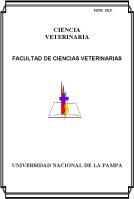Epidemiología de los nematodes gastrointestinales en un establecimiento del departamento Maracó, provincia de La Pampa, Argentina
Keywords:
Gastrointestinal parasites, Helminths, EpidemiologyAbstract
Gastrointestinal parasitism is one of the most important diseases that impact livestock production, producing economic losses, either directly or indirectly with high morbidity and mortality rate. The present work was carried out in naturally infected permanent pastures. Epidemiological data were collected during two consecutive years using twenty steers each year. During the first period (2000/2001) the egg counts per gram of faeces (e.p.g.) increased during autumn-winter, being higher during June-July and decreasing slightly during spring-summer. During the second period (2001/2002) the e.p.g curve, maintained a similar pattern, but the e.p.g counts remained higher until September-October, mostly because of the high level of rains during those two months. In both years the recovery of infective larvae in pasture samples followed the same pattern of the e.p.g. curve. The parasite burden in the abomasum were mainly of Ostertagia spp, followed by Trichostrongylus spp and Haemonchus spp., whereas in the intestine predominate basically Cooperia spp followed by Oesophagostomun spp. and Nematodirus spp. Moreover, Ostertagia spp. The stages were recovery mainly during the spring-summer seasonDownloads
Downloads
Published
How to Cite
Issue
Section
License
Al momento de enviar sus contribuciones, los colaboradores deberán declarar , de manera fehaciente, que poseen el permiso del archivo o repositorio donde se obtuvieron los documentos que se anexan al trabajo, cualquiera sea su formato (manuscritos inéditos, imágenes, archivos audiovisuales, etc.), permiso que los autoriza a publicarlos y reproducirlos, liberando a la revista y sus editores de toda responsabilidad o reclamo de terceros , los autores deben adherir a la licencia Creative Commons denominada “Atribución - No Comercial CC BY-NC-SA”, mediante la cual el autor permite copiar, reproducir, distribuir, comunicar públicamente la obra y generar obras derivadas, siempre y cuando se cite y reconozca al autor original. No se permite, sin embargo, utilizar la obra con fines comerciales.



4.png)


7.png)



